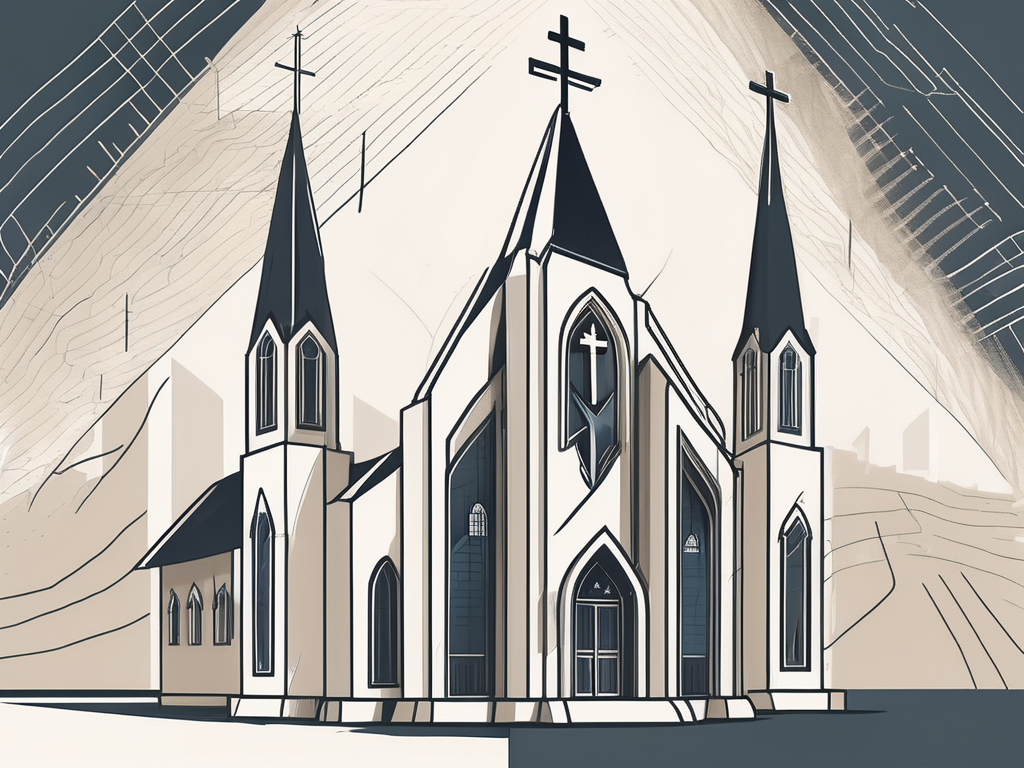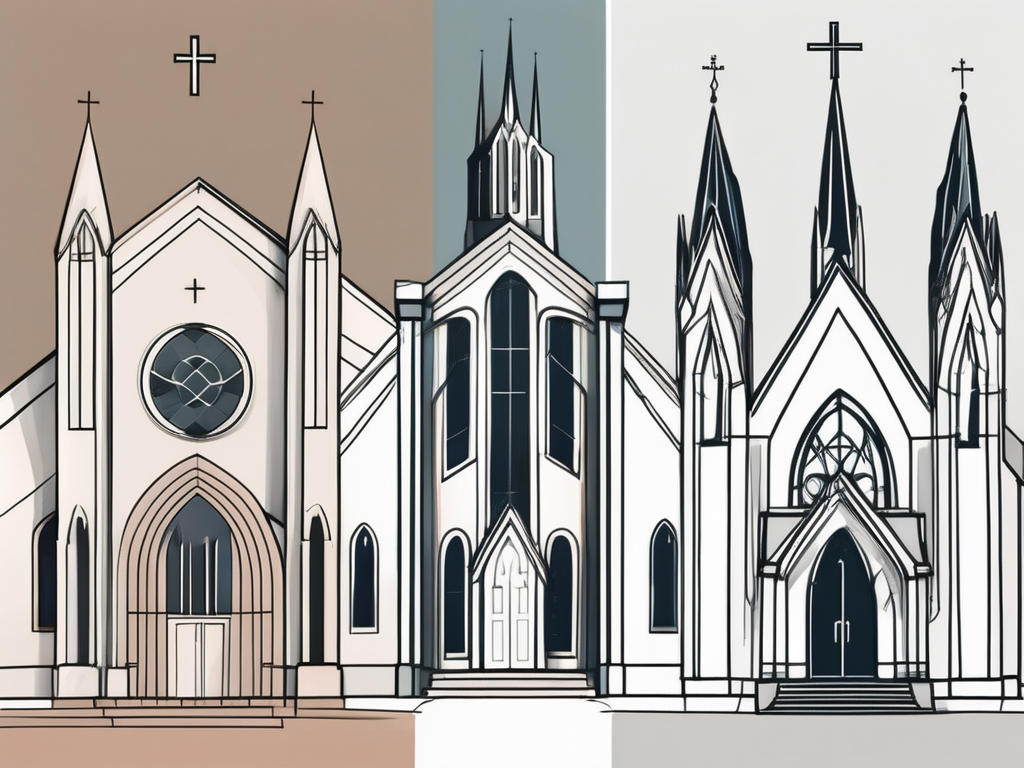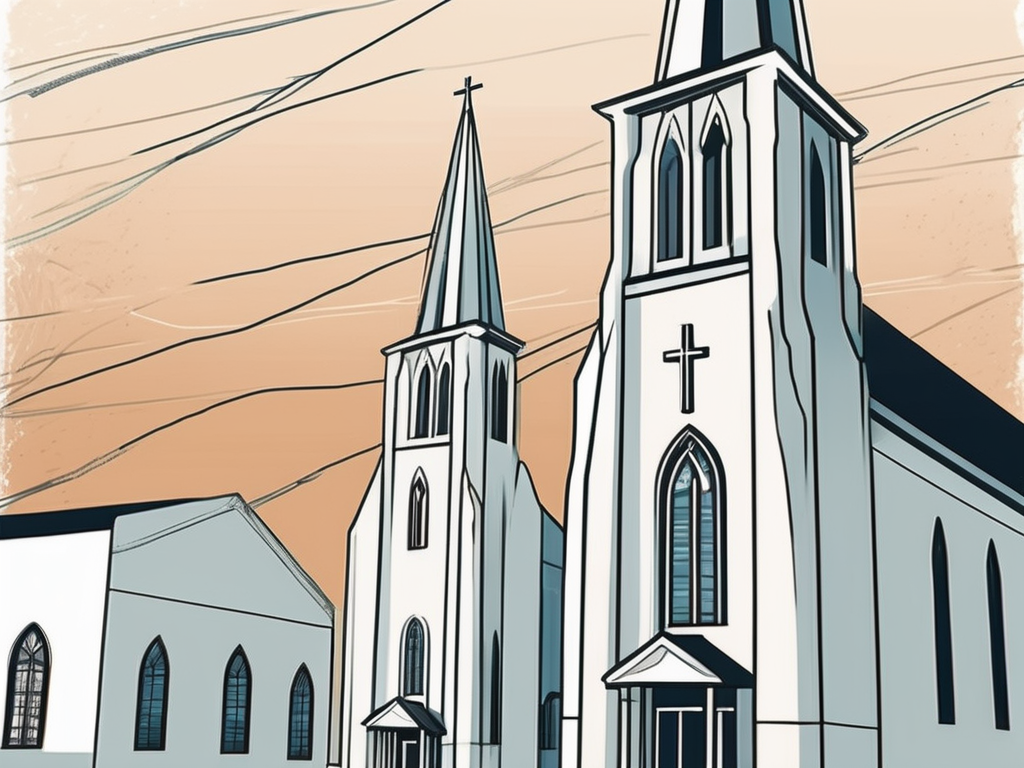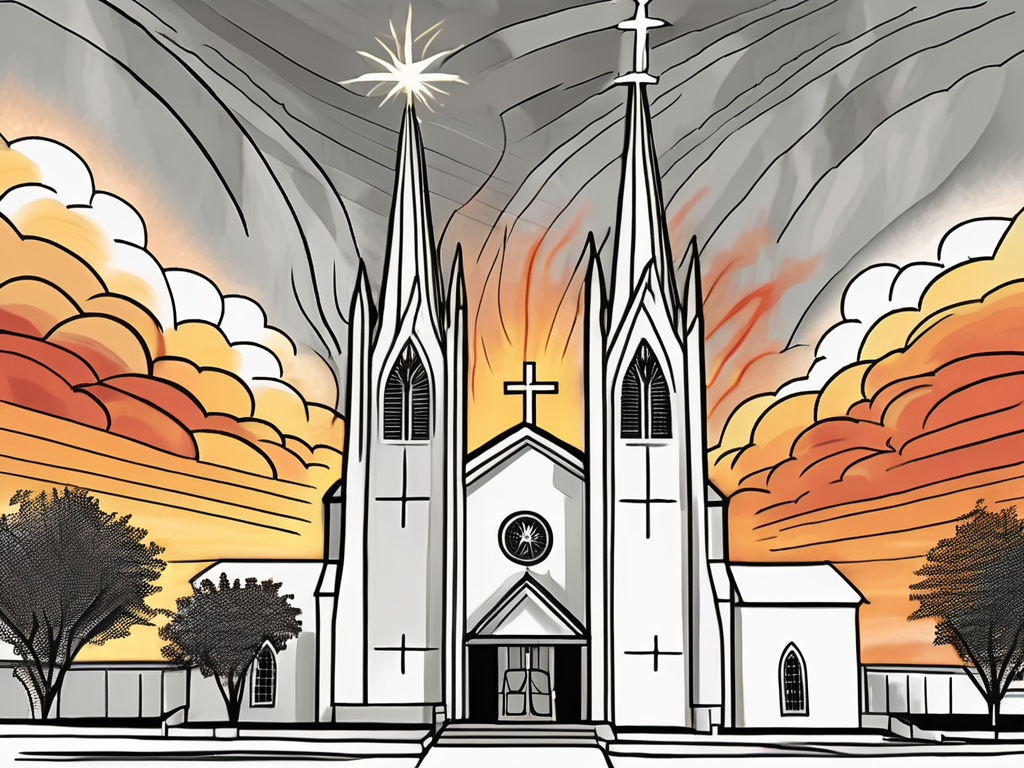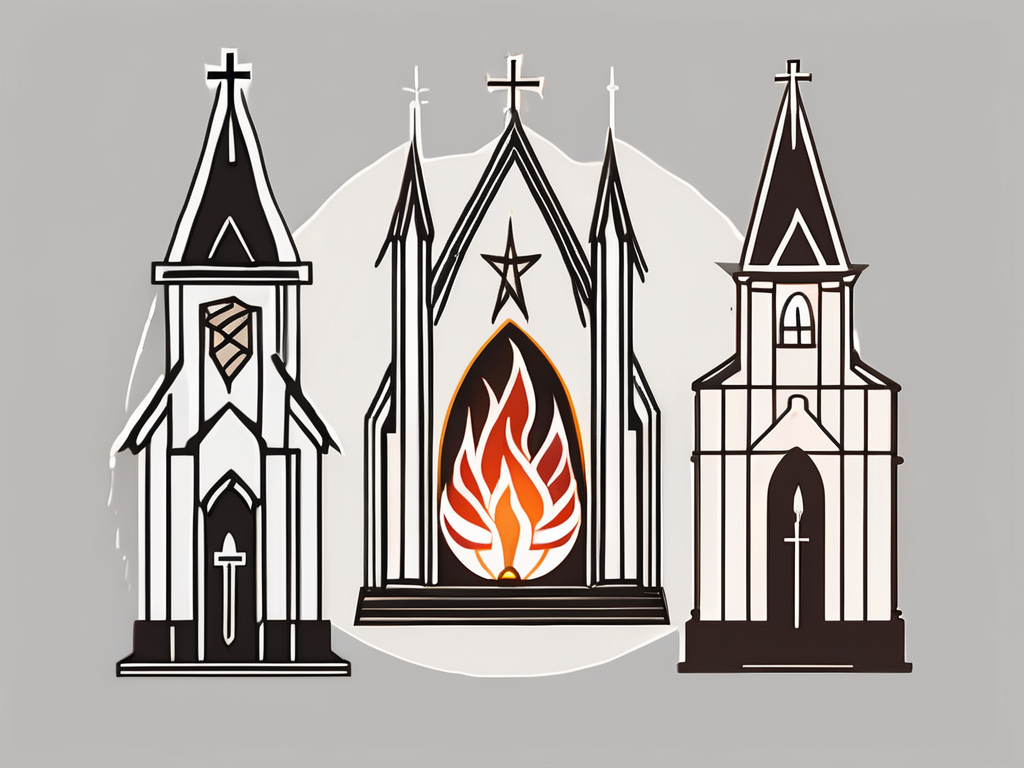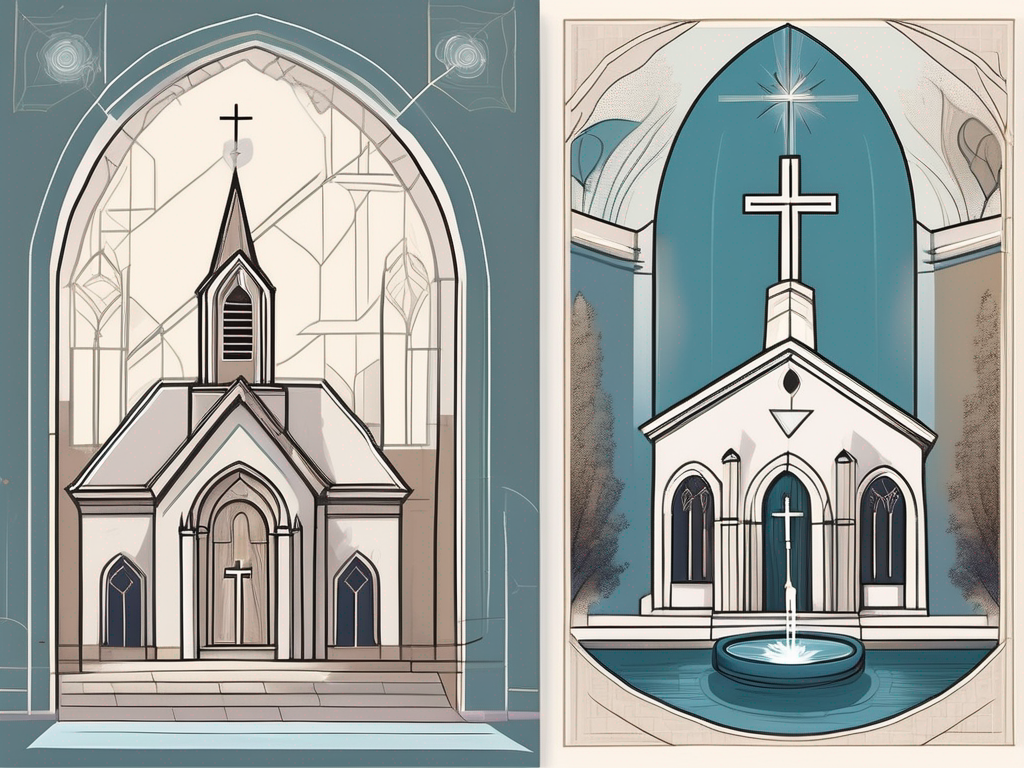In the realm of Christianity, there are numerous denominations with unique beliefs, practices, and worship styles. Two prominent branches are Pentecostalism and Catholicism. While both faiths are centered around Jesus Christ, they differ in various aspects that shape their religious identity. In this article, we will explore the basics of Pentecostalism and Catholicism, delve into their theological differences, examine their worship styles, discuss their structure and organization, and analyze their societal impact and influence.
Understanding the Basics: Pentecostalism and Catholicism
To better comprehend the differences between Pentecostalism and Catholicism, let’s start by examining their origins and historical backgrounds.
Pentecostalism emerged in the early 20th century as a charismatic movement within Protestant Christianity. Its roots can be traced back to the Azusa Street Revival in Los Angeles, California, in 1906. This movement emphasized the baptism of the Holy Spirit, speaking in tongues, and the manifestation of spiritual gifts.
The Azusa Street Revival, led by African-American preacher William J. Seymour, was a significant event in the history of Pentecostalism. It brought together people from diverse racial and social backgrounds, breaking down barriers and fostering unity through the power of the Holy Spirit. The revival sparked a global movement, with Pentecostal churches springing up around the world, each with its unique expressions of worship and spiritual practices.
Meanwhile, Catholicism dates back to the time of Jesus Christ and the apostles. It is considered the oldest form of Christianity and is centered around the authority of the Pope, who is believed to be the successor of Saint Peter. The Catholic Church views itself as the one true Church founded by Jesus, with a hierarchical structure that includes bishops, priests, and deacons.
The early Christian community, from which Catholicism emerged, faced persecution and challenges from both the Roman Empire and various heretical movements. Over time, the Church developed its doctrines and traditions, drawing from the teachings of the apostles and the guidance of the Holy Spirit.
Now that we have a glimpse of their historical backgrounds, let’s explore some key beliefs and practices that differentiate Pentecostalism and Catholicism.
Origins and Historical Background
Pentecostalism originated from the Azusa Street Revival in 1906, while Catholicism traces its roots back to Jesus Christ and the apostles. The early Christian community faced numerous challenges and underwent significant transformations, leading to the development of Catholicism as we know it today.
Throughout history, Catholicism has played a vital role in shaping Western civilization. The Church has been a patron of the arts, preserving and promoting works of literature, music, and architecture. It has also been involved in social and political affairs, influencing the course of nations and advocating for justice and human rights.
Key Beliefs and Practices
Pentecostals emphasize the baptism of the Holy Spirit, speaking in tongues, and spiritual gifts, while Catholics focus on sacraments, traditions, and the authority of the Pope. In Pentecostal worship services, there is often an emphasis on the direct experience of God’s presence and the manifestation of spiritual gifts such as prophecy, healing, and miracles.
Catholicism, on the other hand, places a strong emphasis on the sacraments, which are considered visible signs of God’s grace. The seven sacraments, including baptism, Eucharist, and confession, are believed to convey spiritual blessings and bring believers closer to God. The Catholic Church also upholds the authority of the Pope, who is seen as the successor of Saint Peter and the visible head of the Church on earth.
Both Pentecostalism and Catholicism have their unique expressions of faith and worship. While Pentecostalism emphasizes the direct experience of God’s power and the individual’s relationship with the Holy Spirit, Catholicism places importance on the communal aspect of worship and the rich symbolism found in its liturgical traditions.
As we delve deeper into the intricacies of Pentecostalism and Catholicism, we will discover more fascinating aspects that make these two branches of Christianity distinct and diverse.
Theological Differences: A Closer Look
When examining the theological differences between Pentecostalism and Catholicism, it becomes evident that there are contrasting perspectives on various aspects of faith and practice. These differences shape the beliefs and experiences of followers within each tradition, contributing to the diversity within the broader Christian community.
One of the significant theological differences between Pentecostalism and Catholicism lies in their views on salvation. Pentecostals firmly believe in a personal, individual experience of salvation through faith in Jesus Christ. They emphasize the need for repentance, the acceptance of Jesus as Savior, and the active working of the Holy Spirit in a believer’s life. This emphasis on personal faith and the transformative power of the Holy Spirit is central to Pentecostal worship and spiritual life.
On the other hand, Catholics hold a different perspective on salvation. They believe in salvation through faith and good works. While faith in Jesus Christ is essential, Catholics also emphasize the importance of participating in the sacraments, such as baptism and confession, as well as following the moral teachings of the Church. For Catholics, salvation is seen as a lifelong journey that involves both faith and active participation in the sacramental life of the Church.
Another theological difference between Pentecostals and Catholics is how they interpret the Bible. Pentecostals often take a more literal approach, believing in the infallibility and authority of Scripture. They view the Bible as the inspired word of God and seek to apply its teachings directly to their lives. This emphasis on the literal interpretation of Scripture shapes many aspects of Pentecostal theology and practice.
Catholics, on the other hand, interpret the Bible within the context of Church tradition and the teachings of the Magisterium. While they also recognize the importance of Scripture, Catholics believe that the interpretation of the Bible should be guided by the wisdom and authority of the Church. This approach allows for a more nuanced understanding of the Bible, taking into account the historical and cultural context in which it was written.
Furthermore, the role of the Holy Spirit holds distinct significance for Pentecostals and Catholics. Pentecostals view the Holy Spirit as actively working in the lives of believers, empowering them with spiritual gifts and enabling supernatural experiences. They believe in the continuation of the gifts of the Spirit, such as speaking in tongues, prophecy, and healing. The Holy Spirit is seen as a personal guide and source of power in the daily lives of Pentecostals.
Catholics, while recognizing the presence of the Holy Spirit, focus more on the sacramental grace received through the Holy Spirit and the guidance of the Church. The Holy Spirit is seen as working through the sacraments, particularly in the Eucharist, where Catholics believe they receive the true presence of Christ. The sacraments are considered essential channels of God’s grace and are seen as central to the spiritual life of Catholics.
These theological differences between Pentecostalism and Catholicism reflect the diverse ways in which Christians understand and practice their faith. While there may be disagreements on certain doctrines and practices, it is important to recognize the shared belief in Jesus Christ as the Son of God and the Savior of humanity. Despite the differences, both Pentecostals and Catholics strive to live out their faith and seek a deeper relationship with God.
Worship Styles: A Contrast
When examining the differences between Pentecostalism and Catholicism, one area that stands out is their distinct worship characteristics. Understanding these differences can provide insight into the unique ways in which these two religious traditions express their devotion to God.
Pentecostal Worship Characteristics
Pentecostal worship is renowned for its energetic and spontaneous nature. It is a vibrant and lively experience that often ignites the spirit within believers. The atmosphere is filled with passionate singing, clapping, and even dancing, as individuals pour out their hearts in worship. It is not uncommon to witness people fully surrendering themselves to the divine presence, expressing their love and devotion to God through heartfelt praise.
Moreover, Pentecostal services frequently include extended periods of worship. These moments allow believers to immerse themselves in an atmosphere of spiritual connection, where they can freely express their faith. It is during these times that the presence of God is palpable, and individuals are encouraged to engage in personal acts of worship, such as speaking in tongues and manifesting spiritual gifts.
Furthermore, Pentecostal worship gatherings often emphasize the power of the Holy Spirit. Believers seek to experience the divine presence in a tangible way, and they eagerly anticipate the manifestation of spiritual gifts. This expectation creates an atmosphere of anticipation and excitement, as individuals open themselves up to the supernatural workings of God.
Catholic Worship Characteristics
In contrast to the energetic and spontaneous nature of Pentecostal worship, Catholic worship is more formal and structured. It adheres to a set liturgy and follows a prescribed order of worship. The Catholic Mass, the central act of Catholic worship, is a carefully orchestrated ceremony that incorporates various elements of tradition and ritual.
One of the defining features of Catholic worship is the inclusion of sacraments. These sacred rituals, such as baptism, confirmation, and the Eucharist, hold great significance in the Catholic faith. They serve as tangible expressions of the believer’s connection to God and the community of believers.
During Mass, the congregation engages in the recitation of prayers, readings from the Bible, and congregational responses. The liturgical elements create a sense of unity and participation among the worshippers, as they collectively express their faith and devotion.
Additionally, the ambiance of Catholic churches plays a significant role in the worship experience. Ornate decorations, statues, and artwork adorn the sacred spaces, creating an atmosphere of reverence and awe. The visual elements serve as reminders of the divine presence and inspire worshippers to approach God with humility and respect.
By exploring the worship characteristics of Pentecostalism and Catholicism, we gain a deeper understanding of the diverse ways in which individuals connect with the divine. While Pentecostal worship is marked by its energetic and spontaneous nature, Catholic worship embraces a more formal and structured approach. Both styles offer unique avenues for believers to express their love, devotion, and reverence towards God.
Structure and Organization: Hierarchies and Leadership
Differences in structure and leadership exist between Pentecostalism and Catholicism. These differences shape the way these religious traditions operate and make decisions.
Leadership in the Pentecostal Church
Pentecostal churches typically have a more decentralized structure, where leadership is often shared among pastors and elders. This decentralized approach allows for a greater sense of community involvement and participation. Decision-making processes can vary, with a focus on consensus-building and the direct leading of the Holy Spirit. This emphasis on the Holy Spirit’s guidance is seen as essential in ensuring that decisions align with God’s will.
Within the Pentecostal Church, local autonomy is often valued, allowing individual churches to operate independently within a broader denomination. This autonomy grants pastors and leaders the freedom to adapt their practices and teachings to the specific needs of their congregation. It also fosters a sense of ownership and responsibility among the members, as they actively participate in the decision-making processes that shape their church’s direction.
Furthermore, the shared leadership model in Pentecostalism promotes a sense of equality among pastors and elders. This collaborative approach encourages a diverse range of perspectives and gifts to be utilized in the leadership of the church. It also allows for the development of emerging leaders within the community, as individuals are given opportunities to exercise their leadership skills and contribute to the growth of the church.
Hierarchy in the Catholic Church
The Catholic Church, on the other hand, has a hierarchical structure, with the Pope at the highest level of authority. The Pope, considered the successor of Saint Peter, is regarded as the head of the entire Catholic Church. This centralized leadership provides a clear line of authority and ensures consistency in doctrine and practice across the global Catholic community.
Below the Pope, there are bishops, priests, and deacons, each with specific roles and responsibilities. Bishops oversee dioceses, which are geographical areas within the Church. They are responsible for the spiritual well-being of the faithful in their respective regions and for upholding the teachings of the Church. Priests serve within the dioceses, providing pastoral care and administering sacraments to the local communities. Deacons, while not ordained to the same extent as priests, play an important role in assisting with various ministries and serving the needs of the Church.
The hierarchical structure of the Catholic Church is supported by a well-defined doctrinal framework that guides its teachings and practices. This framework, rooted in centuries of tradition and theological reflection, provides a sense of stability and continuity within the Church. It ensures that the teachings of the Church are consistent and in line with its core beliefs.
While the hierarchical structure of the Catholic Church may seem more rigid compared to the decentralized approach of Pentecostalism, it allows for a unified and coordinated response to various issues and challenges faced by the Church. The Pope, as the central figure of authority, can provide guidance and direction to the entire Catholic community, ensuring that the teachings and practices of the Church remain faithful to its core values.
Societal Impact and Influence
Both Pentecostalism and Catholicism carry significant societal impact and influence.
Pentecostalism’s Influence on Society
Pentecostalism has had a profound influence on global Christianity, particularly in regions such as Africa, Latin America, and parts of Asia. The movement’s emphasis on individual spiritual experiences, community outreach, and social engagement has led to the establishment of numerous churches, schools, hospitals, and charitable organizations. Pentecostalism’s vibrant worship style and emphasis on personal transformation have resonated with many seeking a more experiential expression of faith.
Catholicism’s Influence on Society
Catholicism’s influence spans centuries and continents. The Catholic Church has played a crucial role in shaping Western civilization, influencing art, architecture, education, and social justice movements. Its vast network of educational institutions, hospitals, and charities has contributed to the betterment of societies worldwide. Additionally, the teachings and moral guidance provided by the Catholic Church have had a profound impact on the lives of millions of believers, shaping their values and decision-making processes.
As we conclude this comparative analysis of Pentecostalism and Catholicism, it’s important to recognize that both branches of Christianity have their unique strengths and contributions to the broader Christian faith. While they may differ in practices and theology, they share a common belief in Jesus Christ as the Savior. Ultimately, understanding and appreciating these differences can enhance interdenominational dialogue and foster a more holistic understanding of Christianity as a whole.

